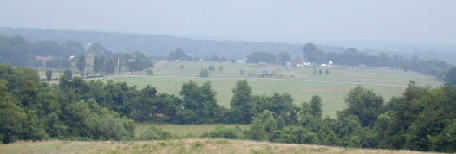ELK NECKMARYLAND |
 |
ELK NECKMARYLAND |
 |

The 1777 British invasion from Chesapeake Bay began in Elk Neck on August 25, 1777. Nearly 300 war and transport ships filled the Elk River and over 15,000 British troops disembarked on both sides of the river. The target of this invasion was the political center of the American rebellion, Philadelphia, the “capital” city of the American colonies.
The British voyage to Elk Neck began from New York City on July 23rd. The destination of this armada, the largest ever launched by the British, was unknown to Washington. He suspected they would come up the Delaware River, but when the ships disappeared off the Delaware Capes for three weeks and were delayed by poor winds and storms, he agonized over where he should move his troops to defend the colonies.
When Howe finally landed at Elk Neck on August 25th, he had lost so much time at sea, that he didn’t set up a normal British encampment. His orders to the troops were not to unload their camping equipment.
Washington, who normally would count tents to estimate the British strength, wrote to Congress:
“They remain where they debarked at first. I could not find out from inquiry what number is landed nor form an estimate of it from the distant view I had of their encampment.”
Overlook of
General Howe’s LandingOn August 25, 1777, after a month’s voyage from New York, 15,000 British Troops led by Sir William Howe disembarked on the shores of the Elk River approximately two miles east of this site. The fleet of 300 vessels which had transported them was under command of the General’s brother, Admiral Richard Howe. Heavy thunderstorms subsided the night of August 27th, when the British began their cautious march toward Philadelphia along both sides of the Elk. On September 11th, they engaged and defeated Washington’s Army in the Battle of Brandywine.
Elk Neck Bicentennial Committee and
Maryland Historical Society
(Elk Neck Marker)
After a rain delay, Howe moved out on August 27th.
Four years later, in September 1781, thousands of American and French troops passed by this area enroute to Yorktown, Virginia. Two weeks earlier, they were stationed north of New York City trying to figure out how to dislodge the British from the city. In a brilliant, tactical move, Washington moved half of his American troops and all of the French forces under General Rochambeau to Williamsburg, Virginia to surround Cornwallis at Yorktown.
